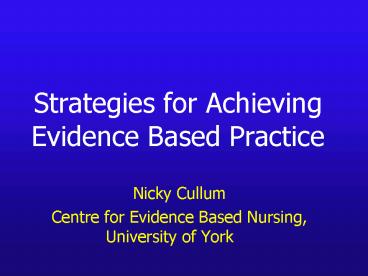Strategies for Achieving Evidence Based Practice - PowerPoint PPT Presentation
1 / 45
Title:
Strategies for Achieving Evidence Based Practice
Description:
... period of bed rest can be reduced or abolished as this bed-blocking is giving her a headache... Longer bed rest. People having diagnostic lumbar ... – PowerPoint PPT presentation
Number of Views:162
Avg rating:3.0/5.0
Title: Strategies for Achieving Evidence Based Practice
1
Strategies for Achieving Evidence Based Practice
- Nicky Cullum
- Centre for Evidence Based Nursing, University of
York
2
Aims
- To introduce you to key principles and processes
of evidence based nursing including strategies
and resources to promote evidence based care
3
Clinical Scenario
- You are a senior nurse on an acute admissions
ward where lumbar punctures are regularly
undertaken for diagnostic purposes. Standard
practice has long been to lie people flat to
reduce the likelihood of headache but the Unit
Manager asks if this period of bed rest can be
reduced or abolished as this bed-blocking is
giving her a headache
4
How long do you think someone should lie flat
after lumbar puncture?
5
REFLECT ON PRACTICE IDENTIFY AREAS OF
UNCERTAINTY
AUDIT
PHRASE ANSWERABLE QUESTIONS
IMPLEMENTATION WHERE APPROPRIATE
SEARCH FOR RESEARCH EVIDENCE
CRITICAL APPRAISAL OF THE RESEARCH
6
Patient Preferences
Evidence from research
Evidence based decision
Professional expertise
Available resources
7
Clinical Decisions (Doctors)
- Achieving a diagnosis
- Estimating a prognosis
- Choosing to intervene
- Choosing an intervention
- Determining Harm
8
What kinds of clinical uncertainty do nurses face?
- Interventions
- Therapy
- Prevention
- Targeting
- Timing
- Diagnosis
- Communicating risks and benefits
- Referral
- Service Delivery/Organisation
- One choice every 10 minutes in acute care
9
Question formation - PICO
- Population (who are the relevant people?)
- Interventions or exposures (diagnostic tests,
foods, drugs, environmental hazards etc) - Control or Alternative intervention/exposure
- Outcome (what are the person-level consequences
we are interested in?)
10
Population
- Who are the relevant people?
11
Intervention
What are they exposed to?
12
Alternative or control intervention
13
Outcome (what are the person-level consequences
we are interested in?)
14
Focusing Answerable Questions
15
Focusing Answerable Questions
16
Focusing Answerable Questions
17
Focusing Answerable Questions
18
Focusing Answerable Questions
19
REFLECT ON PRACTICE IDENTIFY AREAS OF
UNCERTAINTY
AUDIT
PHRASE ANSWERABLE QUESTIONS
IMPLEMENTATION WHERE APPROPRIATE
SEARCH FOR RESEARCH EVIDENCE
CRITICAL APPRAISAL OF THE RESEARCH
20
Fundamental Principle of Evidence Based anything
- The weight given to research evidence for any
decision depends on internal validity and
relevance (external validity) of research - Match the type of question with the best research
design - Certain research designs likely to yield more
valid (more likely true) results for particular
types of questions (minimise bias)
21
Matching questions to designs
22
Randomised controlled trial
OUTCOME
Experimental intervention
NO OUTCOME
Eligible patients
OUTCOME
Control intervention
Direction of data collection exposure ? outcome
NO OUTCOME
23
The total body of research is distilled down to a
conclusion based on the best available, reliable
and relevant research
Poor quality and/or irrelevant research
24
Systematic reviews
- Reviews that look, in a systematic way, at all
the available research on a topic - Systematic reviews have a clear method - like
original research - Critically appraise each piece of research they
include - Reliable information for practice
25
www.nelh.nhs.uk/cochrane.asp
26
Examples of Systematic Reviews from the Cochrane
Library
- Beds, mattresses and cushions for preventing
pressure ulcers - Non-nutritive sucking for pre-term infants
- Absorbent products for containing urinary and/or
faecal incontinence
in adults - Caregiver support for women during childbirth
- Communicating with children and adolescents about
their cancer
27
REFLECT ON PRACTICE IDENTIFY AREAS OF
UNCERTAINTY
AUDIT
PHRASE ANSWERABLE QUESTIONS
IMPLEMENTATION WHERE APPROPRIATE
SEARCH FOR RESEARCH EVIDENCE
CRITICAL APPRAISAL OF THE RESEARCH
28
Only approximately 10 of articles in the most
prestigious internal medicine journals can be
regarded as valid and ready for application
29
Critical Appraisal
- Important for practitioners to be able to sort
the good research from the bad quickly - A number of checklists available different ones
for different research designs - See Evidence Based Nursing Users Guides
- CASP website http//www.phru.org.uk/casp/appraisa
.htm
30
Features of Clinically Useful Information
- Trustworthy (pre-appraised)
- Concise
- Easy to understand
- Easy to access
- Clear implications for practice
31
Sources of Pre-Appraised Research
- Clinical Evidence
32
www.nelh.nhs.uk/clinical_evidence.asp
33
Sources of Pre-Appraised Research
- Clinical Evidence
- Evidence Based journals
- Evidence Based Nursing, Medicine, Mental Health
etc
34
Evidence Based journals
- Aim to select, from international literature,
best quality research and reviews relevant to
medicine, nursing etc - Summarises each article in value-added
abstracts - Commentary from clinical expert
35
(No Transcript)
36
Sources of Pre-Appraised Research
- Clinical Evidence
- Evidence Based journals
- Evidence Based Nursing, Medicine, Mental Health
etc - Systematic reviews
- Cochrane Library (via NeLH)
- Cochrane Database of Systematic Reviews
- DARE - Database of Abstracts of Reviews of
Effectiveness
37
Hayness Typology of Research Information (4S)
Systems
synopses
Synopses
Syntheses (reviews)
syntheses
Studies
38
REFLECT ON PRACTICE IDENTIFY AREAS OF
UNCERTAINTY
AUDIT
PHRASE ANSWERABLE QUESTIONS
IMPLEMENTATION WHERE APPROPRIATE
SEARCH FOR RESEARCH EVIDENCE
CRITICAL APPRAISAL OF THE RESEARCH
39
Evidence Based Implementation
- Growing body of evidence regarding successful
implementation strategies - Multifaceted interventions better than single
interventions eg. audit and feedback, plus
reminders, plus opinion leaders
40
Back to Lumbar Puncture
41
(No Transcript)
42
(No Transcript)
43
(No Transcript)
44
(No Transcript)
45
Where do you start?
- Work with nurse colleagues to identify common
clinical uncertainties - Frame these as answerable, searchable questions
- Search for answers following the synopsis,
synthesis, study approach






![[PDF] Research for Advanced Practice Nurses, Second Edition: From Evidence to Practice 2nd Edition Kindle PowerPoint PPT Presentation](https://s3.amazonaws.com/images.powershow.com/10096647.th0.jpg?_=20240812097)
























